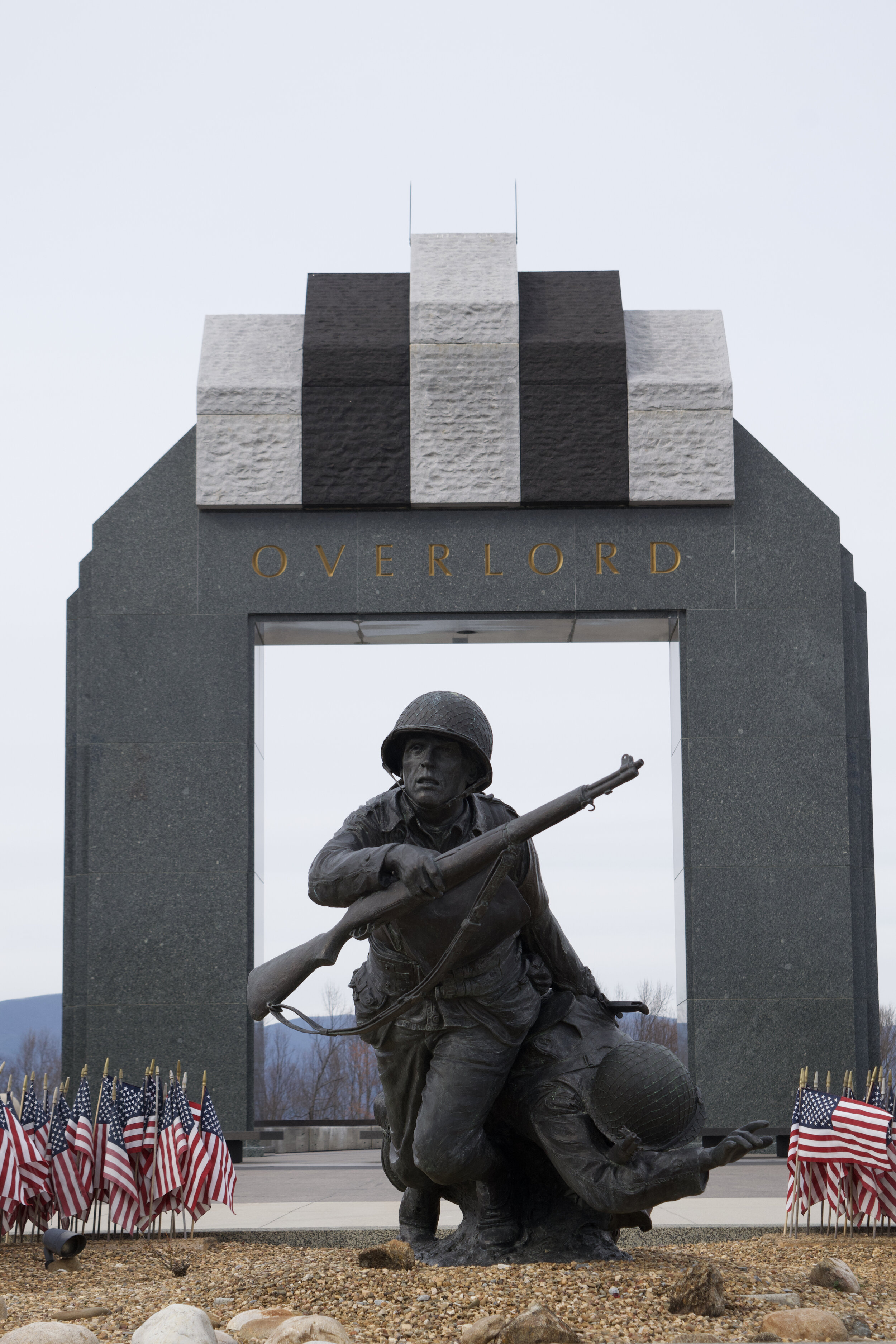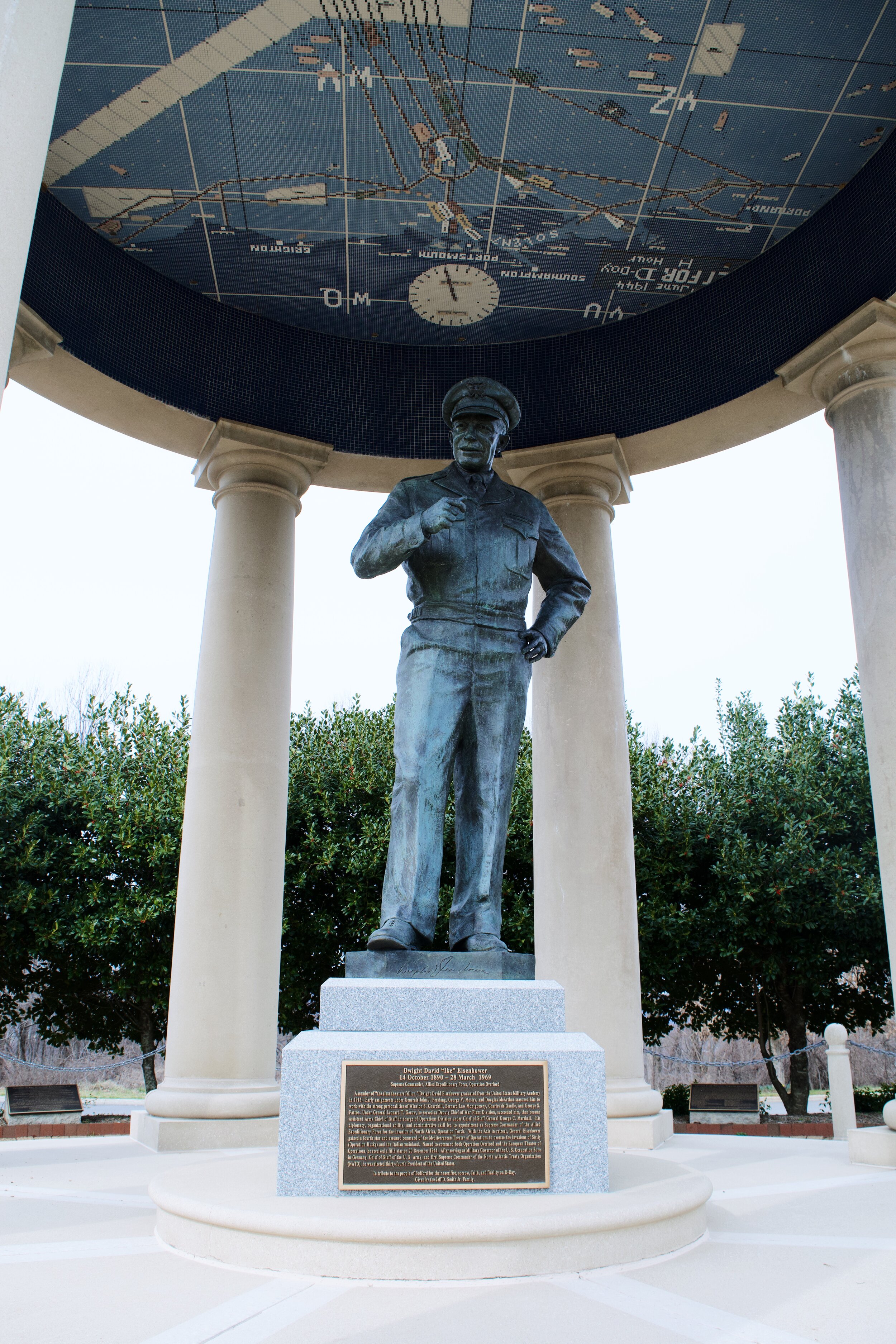The Great Crusade at Home: Traveling to the Bedford D-Day Memorial
“You are about to embark on the great crusade toward which we have striven these many months. The eyes of the world are upon you…. ”
On June 6, 1944, the United States participated in the most daring military operation in human history. The amphibious landings of Operation Overlord combined the best military minds of Europe and the United States in order to successfully begin the liberation of Europe from Nazi tyranny. The protection of global liberty came at a high cost to the brave men and women of the Allied forces. By the end of June 6, over 2,000 American soldiers, sailors, and airmen had been killed. Those individuals represented only a small fraction of the casualties that resulted from Operation Overlord. From June 6 until August 21, The Allies landed more than two million men in northern France, where they suffered 226,386 casualties: 72,911 killed/missing and 153,475 wounded.
The price paid by those in the Normandy Invasion became very poignant for me during the spring semester of my sophomore year at George Washington University when I was privileged enough to take a course called, “The Price of Freedom: Normandy, 1944”. The centerpiece of the course was a biography of a fallen D-Day soldier buried among the over 9,000 interments at the Normandy American Cemetery. Staff Sergeant William L. Ulrich was raised only 25 minutes from my home in South Florida. He was a vibrant member of the Fort Lauderdale community, working at the local pools during the summer. He was also an accomplished student at Fort Lauderdale, playing on the varsity basketball team and being named an honorable mention to the All-American Second Team for football. He was killed on July 4, 1944 while trying to take a hill in France.
Staff Sergeant Ulrich’s story is only one of thousands. Countless families sent their youngest and their brightest to participate in this daring military operation One would find it difficult to discover a community untouched by the Normandy Invasion. No community felt the devastating effects of D-Day more than the town of Bedford, Virginia. About 30 miles from Lynchburg, the small town of less than 7,000 looks unassuming to the average onlooker. Driving through the quiet hamlet that is Bedford it might be easy to confuse it for Andy Griffith’s small town of Mayberry. Despite its size and secluded location, Bedford is home to the national D-Day memorial. Why may you ask? It’s because of a group of valiant young men, known simply as the Bedford Boys.
The sculpture “Homage” was dedicated at the D-Day Memorial in 2014 on the 70th Anniversary of the D-Day landings. As the name suggests, it pays homage to the sons of Bedford that gave their lives on June 6, 1944.
In the early hours of June 6, 1944, the nationalized 116th Regiment of the Virginia Army National Guard (as a part of the 29th Infantry Division) landed on Omaha Beach. For many of the men who joined the National Guard unit, their main incentive was the extra dollar a day and the new uniforms; very few ever thought they might be involved in such a monumental military operation. Among the 116th Regiment was a group of Virginians in Company A, which landed on the most western of the four sectors of Omaha Beach: Dog Green. In Company A, were thirty-seven young men from Bedford; by the end of the day on June 6, nineteen of the thirty-seven men were dead. By the end of the Normandy campaign, four more of Bedford’s finest perished. While 23 may not seem like a small number, the population of Bedford was only about 3200 in 1944. The town of Bedford proportionally suffered the greatest losses of any American town during the Normandy campaign. With this devastating distinction, Congress focused its attention on the small Virginia town and opened the D-Day memorial in 2001.
Nearly 20 years after the memorial opened, I took a trip there with a group of classmates from the Normandy course that I took over the previous spring semester. The pinnacle of our class was supposed to be a trip to Normandy France to deliver our eulogies graveside and explore the sites of the Normandy campaign. The Covid-19 pandemic has stalled that trip, so my trip to Bedford was the closest thing to my trip to Normandy that I would be getting for a while.
A sign at the National D-Day Memorial, indicating the direction and distance of Normandy.
After traveling more than four hours from D.C., we finally arrived at the National D-Day memorial. The initial impression is shocking! Piercing the skyline of Bedford is a tall black structure with the words OVERLORD written in gold. We parked and immediately stopped for bathroom breaks and a quick jaunt in the gift shop. The very kind woman at the gift shop was delighted to see a group of young people spending their spring break studying history. After we purchased our necessary baubles to commemorate the visit, we ventured into the vast memorial complex. A combination of water, beautiful landscaping, and man-made stone/metal structures, the 50-acres of the D-Day memorial are breathtaking.
The central archway of the National D-Day Memorial along with one of the many sculptures that can be seen on the memorial grounds.
Detail of the OVERLORD arch, which serves as not only the focal point of the National D-Day Memorial but as a key part of the Bedford townscape as well.
As we explored the grounds, we stopped and talked about how each portion of the memorial was connected to what we had learned about in class. We even got the attention of other visitors who listened in intently (though socially distanced) to our mini lectures. I was so glad to see the course that I had dedicated so much time to, so well represented by the beautiful art of the memorial at Bedford.
Like with every monument and memorial, everything is done with intention. The centerpiece of the memorial at Bedford is a depiction of what the scene was for the soldiers who landed on D-Day. This section of the memorial features a mock landing craft, beach obstacles, and depictions of three groups of soldiers. In the warmer times, the water would have been turned on to simulate the beaches. Standing behind the land craft, with the door flapped open like it would have been on June 6, it is hard not to imagine yourself facing the terror that the soldiers faced that fateful day. Even without the whizzing of machine gun bullets, cold weather, ocean swells, and artillery fire, the thought is terrifying. The statues of soldiers depicted the variety of experiences that many of the soldiers experienced on June 6. One soldier is seen wading through the water with his rifle over his head, another grouping shows a pair of soldiers charging up a beach, and the third depicts a soldier killed in combat, slumped over on the beach. The section demonstrated the variety of experiences that occurred during the invasion, but also the intense tragedy. In the foreground of this scene is a relief featuring four metal statues climbing up a rock facade. The sculpture pays tribute to the 2nd Ranger Battalion who ascended the cliffs of Pointe-du-Hoc. The sculpture also figuratively represents the Allied forces surmounting the seemingly impregnable defenses of the Atlantic Wall and Hitler’s Fortress Europe.
This relief depicts four metal statues climbing up a rock facade in order to pay tribute to the 2nd Ranger Battalion who ascended the cliffs of Pointe-du-Hoc as well as how the the Allied forces surmounting the seemingly impregnable defenses of the Atlantic Wall and Hitler’s Fortress Europe.
The sculpture depicting a group of soldiers charging up the beach on D-Day. Behind them, the statue of a soldier wading through the water to shore is visible.
Another one of the statues on the faux beach depicting a soldier killed in battle symbolizing the great tragedy and sacrifice behind Operation Overlord.
A decent distance behind the statues on the faux beach and those climbing the rock face stands, General Dwight D. Eisenhower looming tall over the sculpture garden. This portion of the memorial focuses less on the dramatic feats and experiences of the average D-Day soldier, and more on the leaders that made D-Day possible. Around the landscaping that forms the emblem of the Supreme Headquarters Allied Expeditionary Force (SHAEF), are the busts of the leaders of the Normandy campaign. These marvelous depictions include statuettes of U.S. General Omar Bradley (12th Army Group Commander), British Field Marshal Sir Bernard Law Montgomery and Admiral Sir Bertram Ramsay (Allied Naval Commander and mastermind behind the DYNAMO evacuations at Dunkirk). At the center of this circle of leaders stands the Supreme Commander, Dwight David Eishenhower. These great military minds masterminded the massive, complex, and uncertain plan behind the Normandy invasion and led the American troops into battle.
The sculpture garden at the National D-Day Memorial featuring the leaders of the Normandy invasion as well as the emblem of the Supreme Headquarters Allied Expeditionary Force or SHAEF.
The sculpture of General Dwight D. Eisenhower, Supreme Allied Commander, sits at the back of memorial facing forward towards the OVERLORD arch.
The most evident and brilliant feature of the memorial’s main promenade is the towering marble arch that can be seen from some distance over the squat homes and businesses of Bedford. Under this magnificent structure is the emblem of the National D-Day Memorial, as well as a battlefield cross featuring the iconic symbols of WWII: the M1 Garand Rifle and the M1 Helmet. The juxtaposition of this symbol of individual sacrifice right under a tribute to the success of Operation Overlord is a powerful reminder of that price of freedom.
Looking back towards the statue of General Eisenhower from under the OVERLORD arch. In front of Eisenhower, the top portion of the relief commemorating the men who ascended the cliffs of Pointe-du-Hoc is visible as well as the sculpture of the M1 Garand Rifle and the M1 Helmet: some of the many poignant symbols that can be seen at the memorial.
Though these parts of the main promenade are the high points of the memorial, there are plenty of sights to be seen in person. Among these well-curated attractions within the memorial are an L-3 “Grasshopper” aircraft with markings as they would have been seen on D-Day, as well as tributes to American POWs and forgotten units of the Normandy invasion (including African-American barrage balloon operators). All these things are only a small smattering of what is available at the Bedford memorial. For anyone interested in military history would be well served to visit the National D-Day Memorial. It is the only way that you will be able to see all the remarkable sights that it has to offer.










